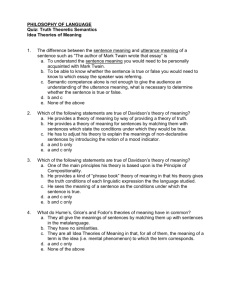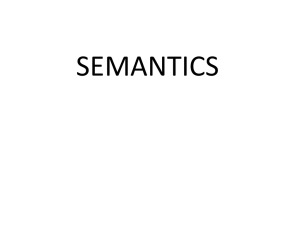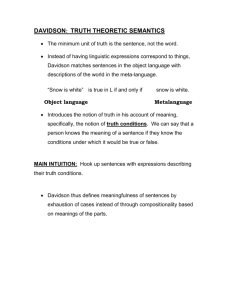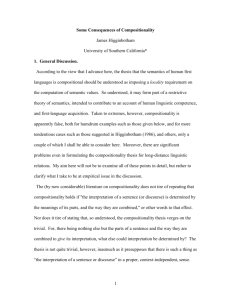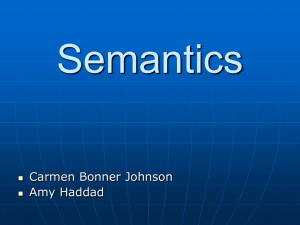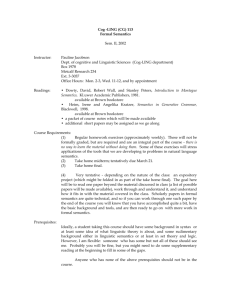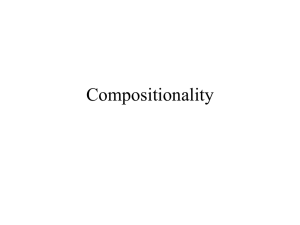Compositionality of meaning
advertisement
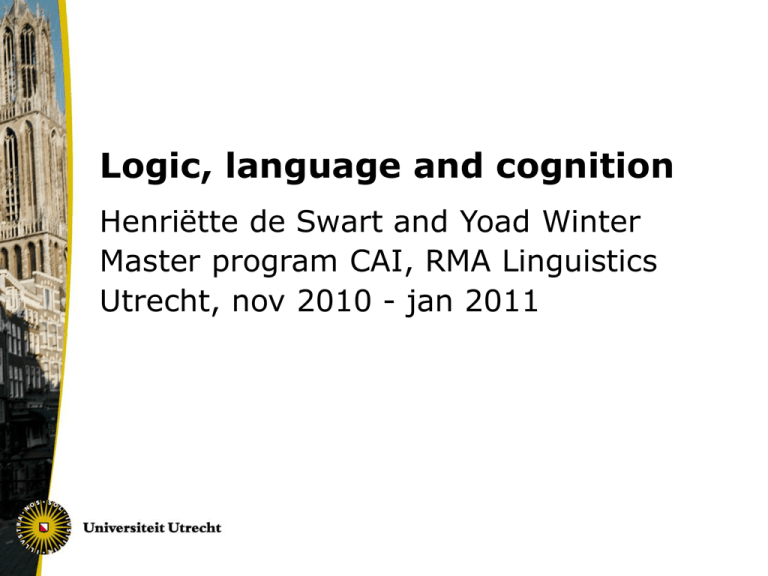
Logic, language and cognition
Henriëtte de Swart and Yoad Winter
Master program CAI, RMA Linguistics
Utrecht, nov 2010 - jan 2011
Background and preliminaries I
• BA: intro to linguistics/logic/cognition,
and developing beginning expertise in
reading academic literature, starting to
work out research questions, developing
relatively small applications.
• MA: introduce advanced methodology
and tools, develop higher level
academic skills, leading to more
advanced research projects and
independent research.
Background and preliminaries II
• MA CAI: Balance between mandatory
courses and optional courses.
• Two tracks:
Cognitive modelling
Logic and intelligent systems
• LLC is a mandatory course offered by
linguistics and feeding into both tracks.
• Core focus: meaning as core business of
language.
• Background reading on semantics for
today: Schlenker (2008).
Background and preliminaries III
• Relevant recommended courses related to LLC in
later periods of the year:
Neurocognition of language (Avrutin, period 2)
Semantic Structures (de Swart/Le Bruyn, 3)
Het sociale semantische Web (Monachesi, 3)
Conceptual Semantics (Zwarts, period 4)
Learning in Computational Linguistics (Winter,
period 4)
Language and cognition
• Language is means of communication in social
community: transfer information from the head
of the speaker to the head of the hearer.
• Questions about language in the mind (language
as part of human cognitive architecture).
• Questions about meaning as content of linguistic
expressions, and target of communication
process.
• Relation between mind and world: truth
conditions.
• Questions about processing meaning in real time.
Logic, language and cognition
• Formal approaches to meaning: role of
logic, syntax-semantics interface,
complexity of grammars, expressivity.
• Embedding in cognitive system: what
model of semantics suits the mind?
Experimental approaches to semantic
processing.
• Applications in artificial systems: use of
grammatical formalisms for computational
applications, modelling meaning in
intelligent systems.
Academic skills acquired in LLC
• Acquire knowledge, tools, methodology and
approaches for doing linguistic research in the
area of cognitive modelling and logic and
intelligent systems.
• Develop skills in reading primary texts in logic,
language and cognition, and being able to
extract the main points, discuss their
contribution to the field, criticize weakness,
suggest further research questions and
alternative approaches.
• Develop skills in formulating research
questions, carrying out this research and
reporting on results.
Approach
• Reading up-to-date literature exposing
students to ‘hot’ questions in the area of logic,
language and cognition.
• Presentation and discussion of foundational
questions defining the field, investigation of
cutting edge tools and methodologies.
• Homeworks developing expertise in tools and
methodologies.
• Balance between instructors’ activity and
students’ activity in the classroom.
• Support in developing academic skills and
individual research.
Overview of the course
• http://www.let.uu.nl/~Henriette.deSwar
t/personal/Classes/LLC10/index.html
• General, Calendar, Exercices, Results
• Requirements: present a paper (25%),
do homeworks (25%), write a final
paper (50%) on a topic related to the
course (meet with one of the teachers
for approval).
• N.B. first paper presentation on Mo Nov
22 – distribute papers over students on
We Nov 17.
Compositionality of meaning as
starting point of semantics
• Core insight: the meaning of any complex
expression is determined by the meanings of
its parts, and the way they are put together.
• Old insight: versions of compositionality have
been around since BC.
• Heuristic principle: semantic theories should
respect principle of compositionality of
meaning.
• But: compositional analysis not always
obvious. How exactly should we formulate the
notion of compositionality? How do we deal
with compositionality problems?
Implications for architecture
• Principle of compositionality has implications
ranging from the lexicon via syntax-semantics
interface to pragmatics and semantics
processing.
• Implications for theory of the lexicon: how to
define the meaning of words in such a way
that they can constitute the input to
compositional rules? What kind of ontology do
we need? Relation between linguistic
knowledge and knowledge of the world.
Implications for syntax-semantics
interface
• How does construction of syntactic trees
relate to construction of complex
meaning? Is there a one-one mapping?
• Background: type theory, basic
syntactic theory about (binary) trees,
categorial grammar.
• Different formalisms, balance between
complicating syntax or complicating
semantics.
Implications for communication
• Implications for semantics-pragmatics
interface: what aspects of meaning are
not immediately derived from
lexicon+syntactic composition but come
in through pragmatic reasoning?
• What are the rules of conversation that
come in at the level of communication
between intelligent agents?
• What is the position of pragmatics in
linguistic theory?
Implications for processing
• Semantic processing by humans: how do we
understand sentences in real time?
• How is semantic processing affected by
compositionality problems?
• How is processing affected by pragmatic
reasoning?
• Processing by computers: how do we design
intelligent systems that process languages as
well as humans?
• Which formal methods and technologies work
best in natural language processing?
Compositionality and implications
• Approach taken in LLC: start with the principle
of compositionality of meaning (today!).
• Explore implications of compositionality of
meaning for theories of the lexicon (We),
syntax-semantics interface and pragmatics.
• At each level, investigate consequences for
semantic processing in experimental
psychology (starting next week).
• Also: consequences for natural language
grammatical formalisms and computational
applications (mostly second half of the course,
focussing on syntax-semantics interface)
Compositionality of meaning
• Reading: Peter Pagin & Dag Westerståhl (2008).
• Questions:
How to formulate the principle of
compositionality of meaning? What are the
advantages/disadvantages of different versions?
Why is it useful to assume that natural language
is compositional for the relation between logic,
language and cognition?
Is it uncontroversial to assume compositionality?
What problems arise if we do/don’t?
Do problems imply we have to abandon the
principle of compositionality of meaning?
Learnability as an argument
• A natural language has infinitely many
meaningful sentences, expressing an infinite
range of propositions.
• It is impossible for a human speaker to learn
the meaning of each sentence one by one.
• It must be possible to learn the language by
learning the meaning of a finite number of
expressions, and a finite number of
construction forms.
• For this to be possible, the language must
have a compositional semantics.
Pagin & Westerståhl (2008: 15).
Novelty as an argument for
compositionality
• Hearers are able to understand sentences they
have never heard before.
• Understanding novel sentences is possible only
if the hearer can assign to new sentences the
meaning that they independently have on the
basis of their knowledge of individual
expressions and rules of putting these
meanings together.
• So understanding novel sentences is possible
only if language is compositional.
Pagin and Westerståhl (2008: 16).
Productivity and systematicity as
arguments for compositionality
• Generative syntax (Chomsky): creativity of
language, production of infinite set of sentences.
• Productivity argument relevant to
compositionality of meaning in so far as new
sentences need to be understood.
(P&W 2008: 15-16)
• Fodor: if a hearer understand a sentence of
the form tRu, she will also understand the
corresponding sentence uRT, and this is best
explained by an appeal to compositionality.
(P&W 2008: 16)
Induction on synonymy
• Fodor: if a hearer understand a sentence of
the form tRu, she will also understand the
corresponding sentence uRT.
• Induction on synonymy: in case after case, we
find the result of substitution synonymous with
the original expression, if the new part is
taken as synonymous with the old.
• Inductive generalization: substitution by
synonyms is meaning preserving.
P&W (2008: 18)
Intersubjectivity and communication
• In most cases, speakers of the same language
interpret new sentences similarly:
intersubjective agreement in interpretation.
• So the meaning of sentences is computable,
not guessed.
• Frege: the proposition has a structure that
mirrors the structure of the sentence:
isomorphism.
• Without this structural correspondence,
communicative success with new propositions
would not be possible.
Critical remarks
• Arguments from learnability and novelty rely
on creativity. Is it justified to assume an
infinite set of propositions?
• Arguments from production are more syntaxoriented than semantics-oriented.
• Not all arguments require full-fledged
compositionality. Often, some notion of
computability is enough.
And yet..
• Even if they are inference to the best
explanation, compositional semantics is very
simple.
• Compositional semantics implies that a
minimal number of processing steps are
needed by the speaker to arrive at a full
expression, and the hearer for arriving at a full
interpretation, and there be communicative
success.
• If we assume compositionality as a viable
starting point – how are we going to define it?
Substitution and function
• Frege: “Let us assume that the sentence has a
reference. If we now replace one word of the
sentences by another having the same
reference, this can have no bearing upon the
reference of the sentence.”
Substitutional version, see P&W (2008: 2).
• Compositionality of meaning requires the
meaning (value) of a compound expression to
be a function of other meanings (values) and a
‘mode of composition’.
Functional version, see P&W (2008: 3)
Structured expressions and grammar
• Set E of linguistic expressions as a domain
over which syntactic rules are defined.
• E is generated by syntactic operations from a
subset A of atoms (primitive expressions,
words).
• is a set of syntactic operations, defined as
partical functions from En to E, such that E is
generated from A via .
• A grammar E is {E, A, }.
• A grammatical term is the analysis tree
associated with the expression (string). GTE is
the set of grammatical terms for E.
Semantics as mapping from terms to
meanings
• Semantics is function from GTE to a set of
meanings M.
• This means that the expression has meaning
derivatively, relative to a way of constructing
it, i.e. to a corresponding grammatical term.
• Distinction between grammaticality (being
derivable by the grammar rules) and
meaningfulness (being in the domain of ).
• No structure imposed upon M besides a
relation of synonymy: u t iff (u) and (t)
are both defined, and (u) = (t).
Basic compositionality: functional
version
• Funct(): For every rule , there is a
meaning operation r such that if (u1,…,un)
has meaning, ((u1,…,un)) = r ((u1), …,
(un)).
• Domain Principle: subterms of meaningful
terms are themselves meaningful.
Basic compositionality: substitution
version
• Subst(): If s[u1,…,un] and s[t1,…,tn] are both
meaningful terms, and if ui ti for 1 i n,
then s[u1,…,un] s[t1,…,tn].
• The notation s[u1,…,un] indicates that the term
s contains – not necessarily immediate –
disjoint occurrences of subterms among
u1,…,un and s[t1,…,tn] results from replacing
each ui by ti.
• DP is not presupposed for the substitution
version.
Functional and substitution version:
equivalence
• Under DP, Funct() and Subst() are
equivalent.
• Basic compositionality takes the
meaning of a complex term to be
determined by the meanings of the
immediate sub-terms and the top-level
syntactic operation.
• Weaker versions of compositionality
arise if we define compositionality at
lower levels of syntactic structure.
Stronger compositionality
• Enlarging the domain of the semantic
function.
• Zabo (2000): same meaning operations
define semantic functions in all possible
human languages, not just for all
sentences in each language taken by
itself.
• Cross-linguistic stability in semantic
operations (‘universal’ semantics).
Additional restrictions on
meaningfulness.
• Husserl property: Synonymous terms
belong to the same semantic category.
Synonymous terms can be intersubstituted without loss of
meaningfulness.
• Huss: u ~ t if, for every term s in E,
s[u] dom() iff s[t] dom().
• Huss imposes more structure on the
syntactic side.
Additional restrictions on meaning
composition operations
• The function version is given by recursion over
syntax, but only if the meanings are defined
by recursion over meanings do we have a a
recursive semantics.
• Rec(): There is a function b and for every
and operation r such that for every
meaningful expression s,
(s) = b(x) if s is atomic
(s) = r((u1), .. (un), u1… un)
if s = (u1… un).
• Standard semantic theories are both
compositional and recursive.
Frege’s Context Principle
• Frege’s Context Principle: The meaning of a
term is the contribution it makes to the
meanings of complex terms of which it is a
part.
• InvSubst(): If u is not t, then there is
some term s such that either exactly one of
s[u] and s[t] are meaningful, or both are, and
s[u] is not s[t].
• That is, if two terms of the same semantic
category make the same contribution to all
complex terms, their meanings cannot be
distinguished.
Strengthening the Context Principle
• Strengthening InvSubst to InvSubst, we can
require that substitution of terms by terms
with different meanings always changes
meaning:
• InvSubst(): If for some i, 0 i n,
ni is not ti, then for every term s[u1,…un] it
holds that either exactly one of s[u1,…un] and
s[t1,…tn] is meaningful, or both are, and
s[u1,…un] is not s[t1,…tn].
Implications for synonymy
• InvSubst disallows synonymy between
complex terms that can be transformed
into each other by substitution of
constituents at least some of which are
non-synonymous, but it allows two
terms with different structure to be
synonymous.
• How closely related should two terms be
in syntactic structure in order to qualify
as synonyms?
Congruence
• Two terms t and u are -congruent iff:
• (i) r or u is atomic, t u, and neither is
a constituent of the other, or
• (ii) t = (t1,…tn), u = (u1,…un), ti and ui
are -congruent for all i, 1 i n, and
for all s1,…sn, (s1,…sn) (s1,…sn) if
either is defined.
• Cong: If t u, then t and u are congruent.
Inverse Functional compositionality
• Cong leads to inverse functional
compositionality:
• InvFunct(): The syntactic expression of
a complex meaning m is determined, up
to -congruence, by the composition of
m and the syntactic expressions of its
parts.
Direct compositionality
• Jacobson (2002).
• In strong direct compositionality, expressions
are built up from sub-expressions by means of
concatenation (left or right).
• In weak direct compositionality, one
expression may wrap around another (as call
up wraps around him in call him up).
• In the weak version of direct compositionality,
substrings are allowed to have discontinuous
occurrences.
Indirect compositionality
• For indirect compositionality, syntactic
operations are loosened up to include
string deletion, string reordering, term
substitution and insertion of elements.
• Distinction between direct and indirect
compositionality relevant for the
definition of the syntax-semantics
interface: what choice of syntactic
theory is compatible with compositional
semantics?
• Important focus of second half course!
Language signs
• Abstract categorial grammar: signs.
• Sign is a triple consisting of a string, a
syntactic category and a meaning.
• Grammar is defined in terms of partial
functions from signs to signs.
• Requires different way of organizing relation
between grammatical terms and their
meaning.
• Abstract categorial grammar will be discussed
in the second half of the course.
Arguments against compositionality
• How controversial is it to assume that
compositionality holds?
• Empirical arguments that certain
constructions are non-compositional.
Counterexamples falsify principle of
compositionality of meaning for natural
language.
• Arguments that compositionality is
trivial, not needed, or not suited to
actual linguistic communication.
Superfluity/unsuitability
• Schiffer (1987): compositionality superfluous
for mental processing.
• But how to translate sentence representations
to mental representations?
• Recanati (2004): pragmatic compositionality,
enrichment of meaning. Requires more
thought about the semantics-pragmatics
interface.
• Radical contextualism, e.g. Sperber and Wilson
(1992): evaluation in context underdetermined
by literal meaning.
Potential counterexamples to
compositionality
• Belief sentences: synonymy not preserved
under verbs of mental attitude.
• Quotation: brother and male sibling are
synonyms, but ‘brother’ and ‘male sibling’ are
not.
• Idioms: kick the bucket means ‘to die’.
• Ambiguities that are not clearly visible in
lexical or structural differences, e.g. scope.
Compositionality for logic and
language
• Principle of compositionality of meaning has
shaped semantic theory.
• Formal approaches favor use of type theory as
a logical language that allows compositional
analysis, cf. Schlenker (2008).
• Primitive objects: Semantics usually defines
interpretation in terms of a domain of
individuals and a set of truth values.
• Rules of interpretation: typically function
application.
Potential problems
• What happens if we encounter natural
language expressions that cannot be defined in
terms of individuals (mass nouns, plurals).
How to extend our ontology? What are the
implications for construction rules?
• What happens if type theory does not allow
composition by function application? E.g. type
conflicts – see coercion stuff!
• Is a syntax-semantics interface using
categories, type theory, and variables
desirable, or should we explore different
approaches – variable free semantics,
‘abstract’ categorial grammar.
Theory-dependent compositionality
problems
• Compositionality problems that arise under
particular assumptions of syntactic or semantic
operations, e.g. negative concord.
• Assume that our semantic composition rule is
function application.
• How to account for the contrast between:
• Nobody talked to nobody [English: ]
• Nessuno ha parlato con nessuno. [Ital: xy]
• Solutions: different lexical entries (2nd nessuno
is not negative), ambiguities (nessuno can
mean either x or x), different semantic
operations from function application (polyadic
quantification).
Processing compositional meaning
• Do ‘repairs’ of compositionality problems (e.g.
coercion in the case of type conflicts) have a
reflection in real time semantic processing
(e.g. slower understanding)?
• How do we deal with ‘enriched’ meanings
(presupposition, implicature): semanticspragmatics interface? What grammatical and
cognitive mechanisms are involved in
pragmatic reasoning?
• How can processing evidence bear on semantic
theory?
Back to class overview
• Organization of topics: relevance of
compositionality for study of logic, language
and cognition.
• First half of course: start with the role of the
lexicon in compositionality problems. Build up
grammar, semantics-pragmatics interface.
Provide processing evidence to test linguistic
theory.
• Second half of the course: Formal modelling of
compositionality problems, scope, dependency
relations. Balance between complicating
syntax/complicating semantics.

